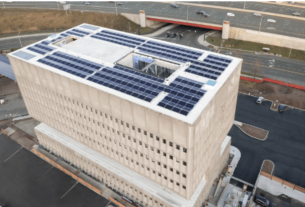Susič et al. share their experience studying solitary bee activity at nesting boxes using passive acoustic monitoring and analysing the data using neural networks.
There are thousands of species of solitary bees and they play important roles in their ecosystems, the best known being the pollinators of various plants. Several species choose holes in wood to make their nests – they fill each chamber they make with pollen and lay an egg that then develops into a new bee. Some of these bees can be attracted with artificial nesting boxes, sometimes also called bee hotels, which are various types of wooden blocks with holes drilled in. Such boxes are gaining prominence in urban settings, where there is a lack of suitable natural nesting opportunities, as well as in orchards, where solitary bees are one of the key pollinators.
In our study, we were interested in the daily dynamics of solitary bees. This is an important research question both in basic and applied research, as better understanding of bee activity can lead to a safer use of pesticides or to monitor how well the emergence of the bees is aligned with blooming of important crops.
Since manual monitoring is a demanding task (and may result in students that were tasked with it to consider alternative careers!), we instead used an approach called passive acoustic monitoring. Here, we use microphones to record the flight buzzing sounds that the bees produce and later use a computer algorithm to figure out when they were active.
For this purpose, we conducted a citizen science study on ten sites where the participants got a nesting box of uniform design and simple USB microphones. The nesting boxes were installed at the homes of participants, such as at window shelves or attached to barn walls under a roof – to protect them from rain. All participants came from the White Carniola, a mostly rural region in the south-east part of Slovenia. An additional box for verification was installed in Ljubljana, in an urban environment, and accompanied with a video camera.
The participants set up the microphones at some point in the morning and collected them later in the day. During the recording, the microphone captured bee flying buzzing sounds, as well as different components of the soundscape, such as birds singing, wind, traffic, and people talking. Traffic sounds were problematic as they have a somewhat similar structure than a flying buzz. Most of the bees observed were from the genus Osmia, such as Osmia cornuta.

science project

science project
The technical part started after the participants had transferred the collected data to our servers. Here, the task was to develop an algorithm that checks individual segments of a recording and decides whether they contain a buzz or not. This was done by first manually labelling parts of the data (which means listening to the recordings and marking buzzes) and then training a computer algorithm to make decisions. We converted audio segments to spectrograms and used a type of a neural network that works well with images. When evaluating the performance of the algorithm in a rural setting, the accuracy, which is the ratio of correctly recognized samples, was above 95%. In the urban setting, it dropped a bit because of higher levels of environmental noise, mostly due to traffic. With the analysis done, we could plot daily activity of bees at individual sites.
The nice aspect of our approach is that it is well-suited to monitor specifically solitary bees that use nesting boxes. By placing a microphone on a plant, we could pick different buzzing pollinators that pay a visit, including honeybees, bumblebees, or beetles. On the other hand, these other pollinators have little reason to visit the nesting box, so we will only hear the solitary bees there.
Our research focused on the technical aspect of identifying the buzzes. As the approach turns out to be performing well, it can now be used in different studies of bee activity. It can also be adjusted to monitor invasive or endangered insect species. In parallel, the project also increased awareness of wild pollinators in local communities of the participants in the citizen science project.
Read the full article ‘Acoustic monitoring of solitary bee activity at nesting boxes’ in Ecological Solutions and Evidence.


